Brewing Beer with Biscuit Malt
Published: August 9, 2025 at 6:47:05 AM UTC
Last updated: December 12, 2025 at 2:31:59 PM UTC
Biscuit malt, hailing from Belgium, is renowned for its unique toasty and bready notes. It's a go-to for homebrewers aiming to elevate their beer's complexity. Its use spans across various beer styles, including American Ale, Belgian Ale, and English Ale. This versatility stems from its distinct flavor profile. By integrating biscuit malt into their recipes, brewers can craft beers with a richer, more refined taste.
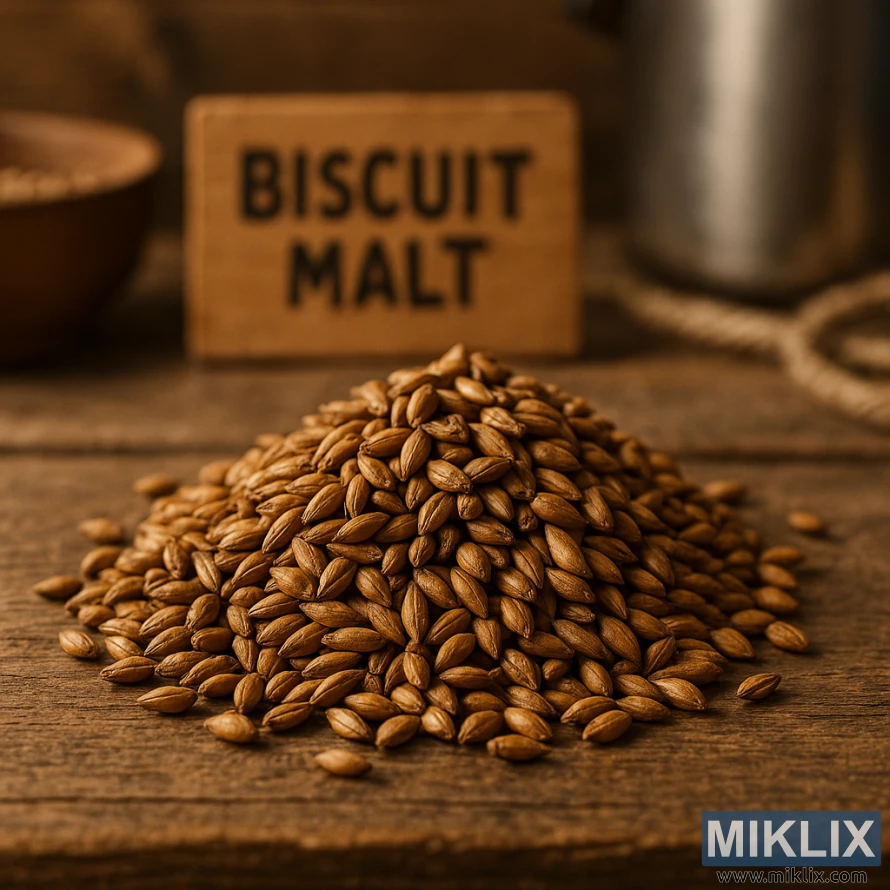
Key Takeaways
- Biscuit malt adds a toasty, bready flavor to beer.
- It is a Belgian-originating specialty malt.
- Commonly used in American Ale, Belgian Ale, and English Ale.
- Enhances the complexity and nuance of beer.
- A versatile ingredient for homebrewers.
What Is Biscuit Malt?
Biscuit malt is known for its unique toasty flavor, making it a staple in many beer styles. It's crafted from barley roasted to a precise temperature, resulting in a malt with a warm brown hue. This roasting process imbues biscuit malt with a toasty, bready taste, appealing to brewers worldwide.
The roasting of biscuit malt is done lightly, typically around 25-30° Lovibond. This gentle roasting preserves the malt's enzymes and enhances its distinct flavor. Brewers use biscuit malt to deepen and enrich beer, adding complexity without dominating other flavors.
Biscuit malt's characteristics make it versatile for various beer styles. It's commonly used in:
- Amber ales, where it adds a rich, malty flavor
- Porters and stouts, where it contributes to a complex flavor profile
- Belgian ales, where its toasty flavor complements other ingredients
By incorporating biscuit malt, brewers can create more nuanced and engaging beer flavors. Understanding biscuit malt's role and how it interacts with other ingredients is key for brewers aiming to innovate and perfect their craft.
The Unique Flavor Profile of Biscuit Malt in Beer
Biscuit malt brings a distinct set of flavors to beer, including a dry, cracker-like quality. This specialty malt is known for its toasty, bready, and cracker-like tastes. It's a great choice for brewers aiming to deepen their beer's complexity.
The biscuit malt's flavor profile is key in balancing sweetness and adding complexity to the brew. Its characteristics include:
- Dry, cracker-like flavors that add a crisp finish to the beer
- Toasty and bready notes that contribute to the beer's complexity
- A balanced flavor profile that complements a variety of beer styles
By using biscuit malt in their recipes, brewers can craft beers with a rich, nuanced flavor. It's a favorite among brewers of American Ale and Belgian Ale. Here, its unique traits shine through.
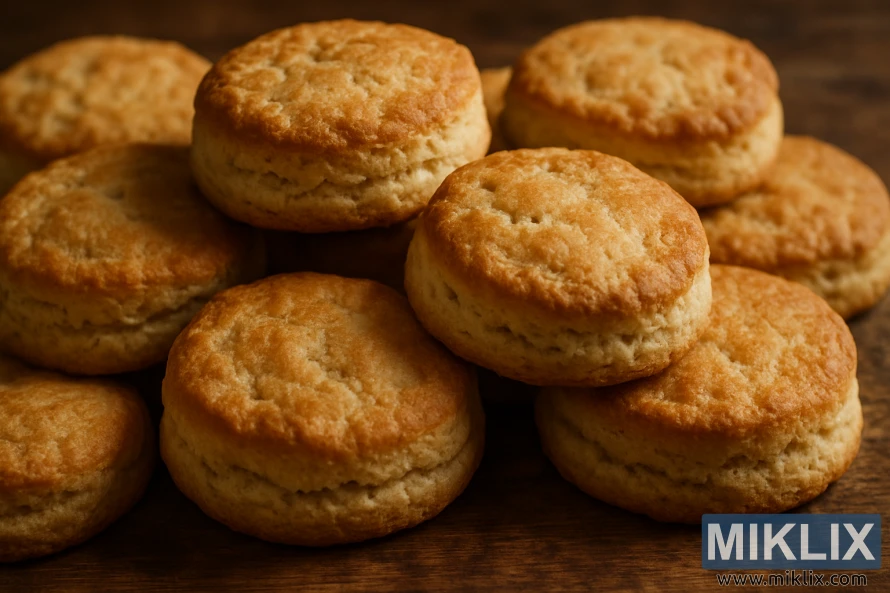
Understanding Biscuit Malt Characteristics
Brewers using biscuit malt must grasp its unique traits to unlock its full benefits. It's roasted lightly, between 25-30° Lovibond, sitting between Munich malt and pale chocolate malt in terms of roast level. This positioning gives it a distinct flavor profile.
The roasting level of biscuit malt greatly affects its taste, adding toasty and bready notes to beer. This makes it a key ingredient for brewers seeking to enhance their beers' complexity.
- Toasty flavors: Adding a warm, comforting element to the beer.
- Bready flavors: Contributing a rich, malty taste.
- Dry biscuit character: Providing a crisp finish.
By understanding these traits, brewers can better predict biscuit malt's interaction with other ingredients. This knowledge helps in crafting beers with balanced and nuanced flavors.
Best Beer Styles for Biscuit Malt Application
The unique flavor profile of biscuit malt makes it an excellent addition to certain beer styles. It's commonly used in brewing American Ale, Belgian Ale, and English Ale. These styles benefit from its toasty, bready flavors.
American Ale is a popular choice for biscuit malt. The malt's dry, biscuit-like flavors complement the hoppy notes often found in this style. Belgian Ale also benefits, with its complex flavor profile enhanced by biscuit malt.
English Ale is another style where biscuit malt shines. It adds a rich, malty flavor characteristic of traditional English ales. The use of biscuit malt in these styles can add depth and complexity, making it a favorite among homebrewers.
- American Ale: Biscuit malt complements hoppy notes.
- Belgian Ale: Enhances the beer's complex flavor profile.
- English Ale: Adds a rich, malty flavor.
When brewing with biscuit malt, it's essential to consider the style of beer you're aiming to create. By choosing the right beer style, you can maximize the benefits of biscuit malt. This creates a complex, flavorful beer.
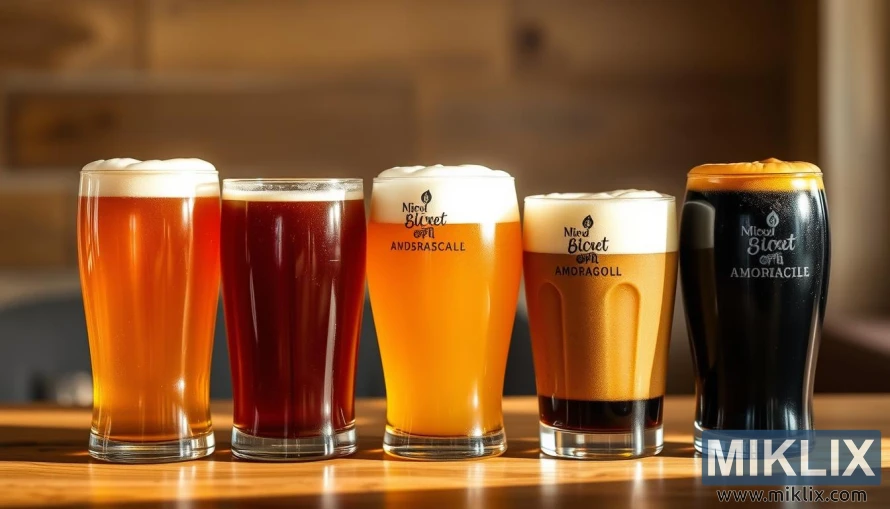
Proper Storage and Handling of Biscuit Malt
Biscuit malt needs careful handling and storage to avoid degradation. It's vital to store it in a cool, dry place, away from sunlight and moisture. This ensures its quality and flavor remain intact.
When handling biscuit malt, brewers must adhere to proper sanitation and handling procedures. This prevents contamination and spoilage. Clean equipment and airtight containers are key.
Some key considerations for storing biscuit malt include:
- Keeping it away from direct sunlight and heat sources
- Maintaining a consistent, cool temperature
- Storing it in a dry, well-ventilated area
By following these guidelines, brewers can ensure their biscuit malt stays fresh and flavorful. This results in high-quality beer.
Temperature Considerations When Brewing with Biscuit Malt
Temperature is key when brewing with biscuit malt, shaping the beer's character. The malt's roasting at about 350°F gives it a toasty, bready taste.
The mash temperature is vital when using biscuit malt. It affects how the malt's starches turn into fermentable sugars. A higher mash temperature can make the beer sweeter and fuller. A lower temperature leads to a drier, more attenuated beer.
To enhance biscuit malt's flavors, brewers should aim for a balanced mash temperature. A range of 152°F to 155°F is often suggested for a rich, complex taste.
- Mash temperature affects the flavor profile and body of the beer.
- A higher mash temperature can enhance the sweetness and body.
- A lower mash temperature can result in a drier finish.
Understanding temperature's role in biscuit malt is critical for a balanced beer. By controlling the mash temperature, brewers can fully exploit biscuit malt's unique flavors. This results in a beer that showcases its distinct taste.
Calculating Biscuit Malt Quantities in Your Recipe
To brew a beer that stands out, understanding how to calculate biscuit malt quantities is essential.
The usage rate of biscuit malt can significantly impact the flavor profile of your beer. As a general guideline, using one pound of biscuit malt (or around 10% of the grist by weight) in a five-gallon batch is considered the maximum for most brews.
When calculating biscuit malt quantities, it's vital to consider the specific beer style and the desired flavor impact. Different beer styles may require adjustments to the amount of biscuit malt used.
- The type of beer you are brewing
- The desired flavor profile
- The overall grist composition
By carefully considering these factors, you can determine the optimal amount of biscuit malt for your recipe.
Common Brewing Mistakes with Biscuit Malt
To fully appreciate biscuit malt, brewers must steer clear of common errors. One major mistake is overusing it. Too much biscuit malt can make beer overly malty or cloying.
Another frequent error is flavor imbalance. Biscuit malt can enhance the maltiness in beers with small bills, like low-gravity bitters, milds, and brown ales. Yet, caution is key to prevent flavor imbalance.
Some brewers might not fully grasp biscuit malt's characteristics. This can lead to unexpected outcomes. For instance, biscuit malt can introduce a toasty, cracker-like taste, which might not fit all beer styles.
To sidestep these errors, brewers should thoughtfully consider biscuit malt's traits. They must also think about how it will blend with other ingredients in their recipe.
By being aware of these common pitfalls, brewers can craft complex, balanced beers. These beers will highlight biscuit malt's distinct flavor.
- Use biscuit malt in moderation to avoid overpowering flavors.
- Balance biscuit malt with other ingredients to achieve a harmonious flavor profile.
- Consider the characteristics of biscuit malt and how it will interact with other ingredients in your recipe.
By adhering to these guidelines, brewers can sidestep common mistakes. This way, they can fully leverage biscuit malt in their brewing endeavors.
Combining Biscuit Malt with Other Specialty Malts
Blending biscuit malt with other specialty malts can significantly enhance your beer's depth and complexity. This approach allows brewers to craft a rich, balanced flavor profile. It's a nuanced way to elevate your brew.
Pairing biscuit malt with various specialty malts can yield unique and intriguing flavors. For instance, mixing it with chocolate malt introduces a deep, roasted taste. On the other hand, combining it with pale malts adds a toasty, bready note without affecting the color.
Common blends include biscuit malt with Munich or Victory malt. These combinations create a complex, malty taste. Exploring different specialty malt pairings can lead to the creation of distinctive, delicious beers.
When blending biscuit malt with other malts, it's critical to consider the desired flavor profile. Adjusting the proportions is key to achieving a balanced and complex taste. This flexibility allows brewers to craft a wide array of flavors.
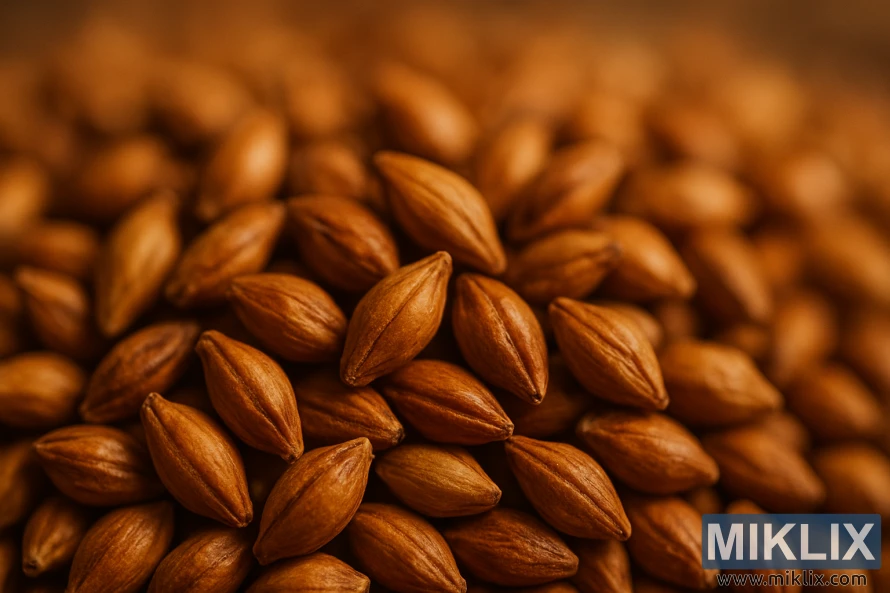
Commercial Examples of Beers Using Biscuit Malt
Biscuit malt brings a unique twist to many beer styles, from American Ales to Belgian Ales. It's celebrated for its rich, toasty flavor. This adds depth and complexity to the beer.
Many renowned breweries have harnessed biscuit malt in their recipes. For example, some American Ales use it to balance out the malty sweetness with hoppy notes. Belgian Ales, on the other hand, benefit from biscuit malt's subtle toasted character, enriching their complexity.
- American Ales: Some breweries use biscuit malt to create a balanced flavor profile.
- Belgian Ales: Biscuit malt is often used to add complexity and a hint of toastiness.
- English Ales: The malt contributes to a rich, malty flavor characteristic of traditional English ales.
Studying these commercial examples offers brewers a wealth of knowledge. It shows how biscuit malt can transform various beer styles. Whether crafting an American Ale, Belgian Ale, or English Ale, biscuit malt is a versatile tool to elevate your beer's taste.
Troubleshooting Your Biscuit Malt Brew
Troubleshooting is a critical skill for brewers aiming to perfect their biscuit malt brews. Biscuit malt, with its toasty and cracker-like flavors, can pose challenges in the brewing process.
Common issues with biscuit malt include flavor imbalances, inappropriate mash temperatures, and fermentation problems. Recognizing these challenges is the first step to resolving them.
Flavor balance is a primary concern with biscuit malt. If the beer seems too malty or sweet, adjustments are needed. For example, increasing hop bitterness can balance out the sweetness from the malt.
Mash temperature is key to extracting biscuit malt's flavors. A too-high temperature can make the wort overly fermentable, leading to dryness or imbalance. On the other hand, a too-low temperature may not extract the malt's full flavor, resulting in a less flavorful beer.
Fermentation issues can also occur with biscuit malt. It's essential to ensure the yeast is healthy and pitched at the correct temperature. Monitoring fermentation and making necessary adjustments can help avoid problems.
To troubleshoot brewing issues with biscuit malt, brewers can take several steps:
- Review the grain bill and consider adjustments to achieve a better balance.
- Check mash temperatures and ensure they are within the optimal range for biscuit malt.
- Monitor fermentation closely and be prepared to make adjustments as needed.
By following these steps and understanding biscuit malt's characteristics, brewers can effectively troubleshoot and enhance their brews.
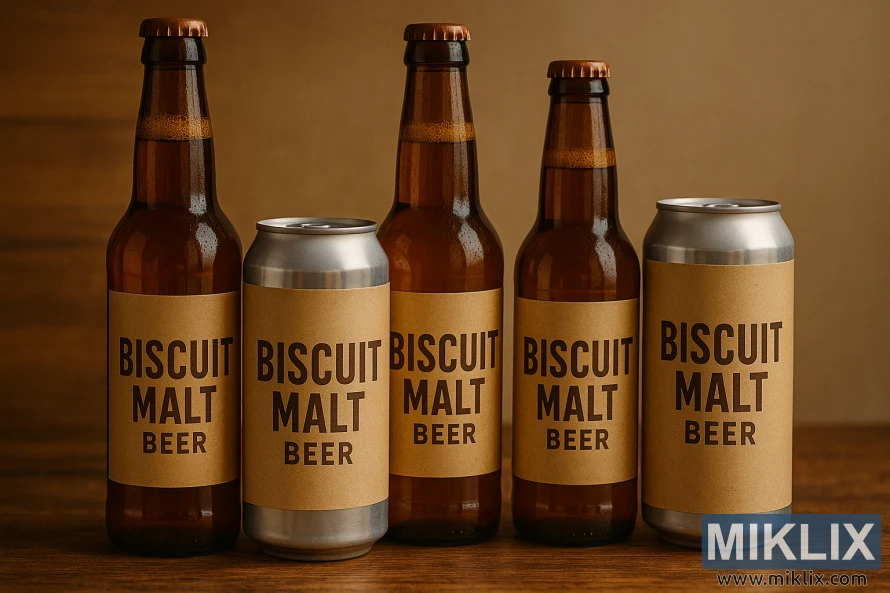
Advanced Brewing Techniques with Biscuit Malt
The unique flavor profile of biscuit malt makes it perfect for experimental brewing. By adding biscuit malt to your recipes, you can craft complex and balanced flavors. This elevates your beer to new heights.
One way to advance brewing with biscuit malt is to mix it with other specialty malts or ingredients. For instance, combining biscuit malt with fruits or spices can lead to fascinating flavor combinations.
To start experimenting, consider these techniques:
- Blend biscuit malt with other malts to create a unique grain bill.
- Experiment with different hopping rates and styles to complement the biscuit malt flavor.
- Incorporate fruits, spices, or herbs into your brew to add complexity.
When trying new recipes, it's vital to keep detailed records of your process and results. This helps refine your techniques and reproduce successful brews. Advanced brewing with biscuit malt is about exploring new possibilities and creating innovative beers. It showcases the versatility of this specialty malt.
Health and Safety Considerations
Handling biscuit malt safely is key to a successful brew. Brewers must recognize the hazards of malt handling, like dust exposure and contamination risks. It's vital to follow proper sanitation and handling procedures to mitigate these risks.
When working with biscuit malt, brewers should wear protective gear. This includes gloves and a dust mask to prevent exposure to allergens and irritants. Ensuring the brewing area is well-ventilated also helps minimize the risks of inhaling malt dust.
To prevent contamination, all equipment and surfaces that come into contact with biscuit malt must be thoroughly cleaned and sanitized. This includes storage containers, brewing vessels, and any utensils used in the brewing process.
By prioritizing health and safety, brewers can ensure a safe and successful brewing experience. This involves being mindful of the hazards of biscuit malt and taking proactive steps to mitigate these risks.
Conclusion
Biscuit malt is a versatile and complex specialty malt that can add depth and complexity to a wide range of beer styles. By understanding its characteristics and usage, brewers can create unique and balanced flavor profiles.
Its toasty, cracker-like flavor can enhance various beer styles, from pale ales to darker brews. Proper storage, handling, and temperature considerations are key when working with biscuit malt. This ensures the desired flavor profile is achieved.
Incorporating biscuit malt into your brewing repertoire can elevate your beers, providing a rich, nuanced taste experience. Whether you're a seasoned brewer or just starting out, experimenting with biscuit malt can lead to exciting new creations. It also deepens your understanding of the brewing process.
As you continue to explore the world of specialty malts, biscuit malt stands out as a valuable ingredient. It's perfect for crafting distinctive, high-quality beers that showcase its unique characteristics.
Further Reading
If you enjoyed this post, you may also like these suggestions:
